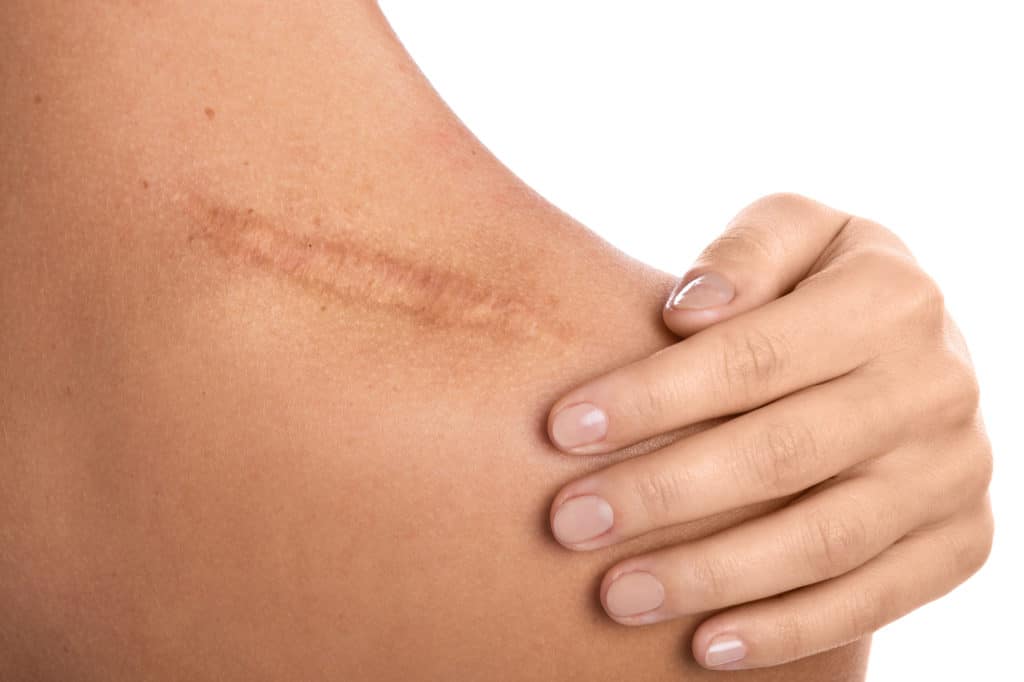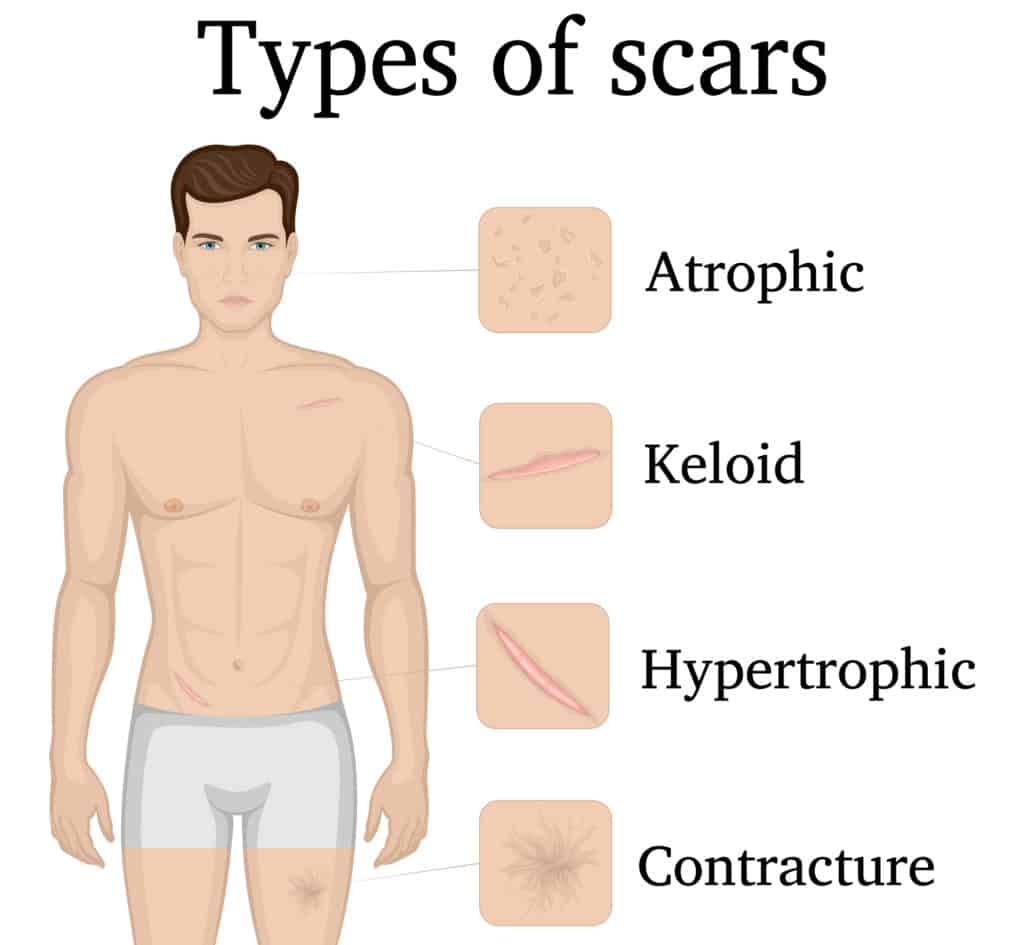
Are you scheduled for surgery and worried about scarring?
When you go in for surgery, it is always inevitable that scarring will occur. However, the good news is that we can reduce the scar tissue that does occur. How do we do this? By preparing your body for the procedure and then taking good care of the area post-surgery.
How Long Does Scar Tissue Take To Heal?
While some people are fortunate enough to have skin and connective tissue that heals rapidly with minimum problems, others take longer to heal and sometimes, unfortunately, develop chronic pain and other issues because of the scar tissue. This scenario is even more likely if you suffer from immune system problems or diabetes, or have pre-existing tensions, tightnesses, and adhesions, otherwise known as myofascial restrictions and problems.
What Causes Surgical Scars and Scar Tissue?

In simple terms, whenever there is damage to the skin or deeper myofascial layers of connective tissue, there is potential for scar formation. So, for instance, when we bruise our shins or knees, break a bone, or twist and stretch ligaments repeatedly while playing sports, it can lead to scars that potentially stay there for life.
These types of scars and scar tissue can also be the catalyst for chronic pain in later life. More on that later. But, in much the same way as these injuries do, the damage that surgery causes to the skin and deeper myofascial layers (connective tissue) also results in scar formation to greater or lesser degree.
All surgeries, even small incision, laparoscopic types, require your surgeon to cut through multiple skin and connective-tissue layers, especially when you have a major surgical procedure like total hip replacement or spinal surgery. Choosing a highly skilled surgeon can help minimize the potential for scar tissue to an extent. However, even in the case of a cosmetic surgery procedure with the finest (and most highly recommended) plastic surgeon around, there is still a possibility that more, rather than less, scar tissue will form because certain factors are beyond the surgeon’s ultimate control.
Below are some of the commonly mentioned factors besides the surgeon’s skill which contribute to how scar tissue forms after surgery. However, most of these factors and the typical discussion of scarring in general are centered around superficial skin scars. The more pronounced and problematic scar tissue that forms deeper in your fascia and connective tissues after surgery is rarely talked or even thought about. You should realize that whatever you see on the surface is just the tip of the scar tissue. The hidden part of the scar goes at least as deep into your tissues as the surgery or injury did. This ignored, deeper scar tissue is the bigger problem in our experience. Keep that in mind as you consider your own existing or potential scars. The commonly known factors for scars include:
- Age: When we age, our skin loses its elasticity and gets thinner because collagen levels decrease when we grow older. Along with that, the layer of fat below the skin surface also gets thinner. Both issues can affect healing by increasing recovery time and the potential for problematic scar tissue to form.
- Sunlight: The greater your exposure to UV rays from direct sunlight (especially in areas with hotter daily temperatures), the more likely you will develop a scar on the skin.
- Nicotine: If you smoke, you are more likely to suffer from scar tissue formation after surgery. Why? Because of the effects of nicotine on the body and other chemicals that damage the texture and structure of the skin.
- Pollutants: If you live in a big city where your skin is exposed to various chemical contaminants in the environment, it can affect the quality of your skin and its ability to heal.
- Race factor: Your race can also be a determining factor in the formation of scars. For example, Africans tend to be more prone to keloid and hypertrophic scars, which causes overgrowth of a scar over injured tissue. Also, if you have dark skin, your skin is likely to scar in a darker color than the surrounding skin. Conversely, the opposite is true if you have light skin. Scars are typically a close to an exact match to the surrounding skin color and often fade away to become almost invisible in time.
- Genetically predisposed: Some individuals have a genetic predisposition from their parents and grandparents to be more likely to develop scars. If you know this to be true in your case, you should discuss it with your surgeon before the operation.
- Kind of incision: The larger the incision, the greater the chances of scarring. Likewise, the longer and deeper the cut, the more prolonged the recovery time – with a higher possibility of scarring. One of the causes of this greater propensity is that the bigger an incision is, the more likely it is to cause stress to the surrounding skin when you move, which delays healing.
How To Prevent Scar Tissue Formation

The silver lining is that there are specific ways to reduce the effects of scar tissue. Common pre-and post-surgical instructions include:
- Stay Hydrated: Lack of adequate hydration leads to dehydration when the body does not get enough fluids. Apart from causing medical conditions, it can lead to fatigue and generally feeling a bit below par. Dehydration also harms the texture of the skin and your connective tissue. So, getting adequate hydration is especially essential for healing after surgery. Try to avoid caffeine and alcohol, too, as they are among the leading dehydration causes.
- Weight control: If you’re overweight or obese, you are more prone to developing scar tissue post-surgery. The reason is that the excess fat layer below the skin will prevent even the most experienced surgeon from closing your incision seamlessly.
- Kick the nicotine habit: Quitting smoking is one of the most challenging habits because of its highly addictive nature. However, giving up smoking will do you good both mentally and physically. Besides delaying recovery time, smoking also increases the risk of developing scar tissue after surgery. If you want to reduce any surgical risks, including scarring, before a surgical procedure, it is best to quit the habit two weeks or more before the procedure.
- Eat a wholesome diet: One of the keys to health and healing is having a healthy and wholesome diet that includes leafy green vegetables and fruits in adequate quantities. Increasing your intake of lean proteins will also help keep your skin and connective tissues healthy and assist in faster healing. Try to include a variety of legumes, fruits, seafood, chicken, fresh vegetables, dairy products, etc. They can all help improve your body’s ability to heal and recover.
- Management of underlying medical conditions: Certain existing medical conditions weaken the body’s natural immune system and ability to heal. Diabetes is one of the leading causes of delay in healing the body and the skin. Keeping your glucose (blood sugar) levels in control before a surgical procedure can help you recover quicker and reduce your chances of developing scar tissue. This connection between blood sugar levels and healing is true even if you don’t have diabetes.
- Get sufficient rest: After surgery, follow your surgeon’s instructions to the letter. When it comes to rest, if they advise two or four weeks or even longer, follow what is said to help in quicker recovery. Don’t take any chances that could hamper the results of your surgery.
- Avoid stress on the operated area: Depending on the type of surgery you have, avoid specific movements like bending or carrying weights. These movements can stretch or cause the skin in the operated area to undergo stress. This stress can damage the sutures and the delicate connective tissue, prolong your recovery, and increase the possibility of scar formation.
- Avoid direct sunlight: After your surgery, take extra care not to expose the operated area to direct sunlight. Try to keep it covered. Do not use sunscreen until your doctor removes the stitches and the skin has healed completely.
How Myofascial Release Therapy Prevents Scar Tissue

We’ve covered some ways you can avoid superficial scars on the skin after surgery, but what about the deep and longer-lasting effects of surgical procedures? The wounds and scars we can’t see?
Unlike traditional physical therapy, which focuses on specific muscles and joints in isolation, Myofascial Release Therapy is a holistic treatment that focuses on the myofascial connective tissue. This sensitive – often overlooked, nerve-filled living tissue runs the length and breadth of our bodies. It’s the stuff your surgeon cuts through to get to the joint, ligament, or organ they’re operating on. As a result, Myofascial Release Therapy is the perfect therapy modality to prevent chronic pain and treat surgical scar tissue. Furthermore, this type of therapy can even undo the damage and treat scar tissue formed even after a surgery decades ago.
Those most interested in avoiding problems and getting the best results should consider both the state of their myofascial health, restrictions and troubles in the myofascial system, before the surgery as well as minimizing the scarring effects of the procedure afterwards. Surgeons know that some bodies are easier to work with than others. They’re not always familiar with why, but it’s due to the amount of distorting restrictions and tightness in your myofascial tissue that you go into the surgery with. If your system and tissues are already tight and pulled, surgery is much more difficult and outcomes are more troubled.
On the other hand, if your body is fluid and pliable when you go in, surgery itself, the recovery afterwards, and the results you get all do and go so much better.
As for recovery, surgery is a major thing to your body. It gets downplayed, but there is a reason you have to be locally numbed out or generally knocked out. You might not notice how major an event a surgery was, but your body sure did. It will need help recovering as completely as is possible. Many people, even those with quick recoveries, do not have as thorough a recovery as they ought to. This sets them up for problems somewhere down the road, either soon or years later.
Traditional physical therapy helps with this, but even the best PTs still aren’t that versed in the influence of the myofascial system. Besides, they’re focused on strength. Helpful, but a different angle altogether.
We believe everyone who is facing surgery would do much better if they both prepared for and recovered from the procedure with some deliberate focus on the health of their myofascial system.
For those who would like to have both the best experience and outcome from their surgery, we use a 3-phase approach.
We help you
- Re-set your nervous system so your mind is at ease and healing is most available
- Restore fluidity and plasticity in your connective tissue system so the procedure is less stressful overall and recovery is easier and more complete
- Re-train your body to move well and build strength by helping you not get stuck in poor movement patterns of compensation and avoidance
In short, we help you move into a healing cycle – instead of being stuck in a pattern of tension, pain, stress, and anxiety.
Want to learn more about how we can help you prepare for and recover from major surgery? Please get in touch now to book your free consultation.

